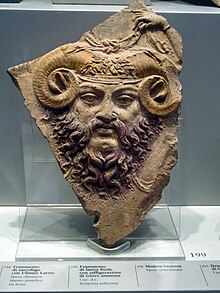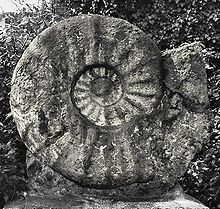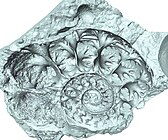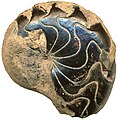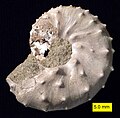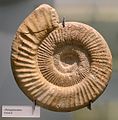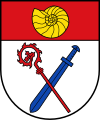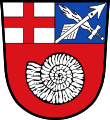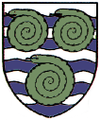Ammonites
| Ammonites | ||||||||||||
|---|---|---|---|---|---|---|---|---|---|---|---|---|

Historical representation of living ammonite animals by Heinrich Harder . The reconstruction of the arms as cirrus and the interpretation of the aptych as a hat cap are considered outdated. |
||||||||||||
| Temporal occurrence | ||||||||||||
| Emsium ( Lower Devonian ) to Maastrichtium ( Upper Cretaceous ) | ||||||||||||
| 407.6 to 66 million years | ||||||||||||
| Locations | ||||||||||||
|
||||||||||||
| Systematics | ||||||||||||
|
||||||||||||
| Scientific name | ||||||||||||
| Ammonoidea | ||||||||||||
| Zittel , 1884 | ||||||||||||
The ammonites (Ammonoidea) are an extinct subgroup of the cephalopods . This taxon was very rich in shape with over 1500 known genera . The number of species is likely to have been around 30,000 to 40,000. The size of the shell of adult animals is usually in the range from 1 to 30 cm. A famous exception is parapuzosia seppenradensis - with about 1.80 m shell diameter, this is the largest known species ammonites have been making their first appearance in. Lower Devonian until their extinction at the end of the Cretaceous ( Cretaceous-Paleogene boundary ) over a period of about 350 million years ago a large number of the index fossils ; In some cases, the temporal delimitation of marine sediments is exclusively based on ammonites. They are therefore of great importance for geology and paleontology . Because of their diversity and frequency , they are also popular with many fossil collectors and are accordingly often found in the fossil trade.
Origin of name
The taxon Ammonoidea was mentioned for the first time in 1884 by Karl Alfred von Zittel (1839–1904) in his handbook on paleontology . The name comes from ancient times , Pliny the Elder referred to fossils as "Ammonis cornua" (Ammon's horns). Amon or Ammon was the name given to the ancient Egyptian sun god Amun-Re by the Greeks and Romans , whom they equated with their king of gods as Zeus or Jupiter Ammon. In its original Egyptian version, this god was often represented as a ram with corresponding horns, and in the Greco-Romanic version as a human being with ram horns. The shape of many ammonite species and their external sculpture, especially the ribs, are reminiscent of the coiled horns of male sheep. However, it is believed that Pliny the Elder did not actually describe ammonites, but rather fossil snails of the genus Natica as Ammon's horns. The component -ceras or -ceratidae many scientific names of ammonite genera or - family is derived from the Greek word κέρας for " horn " decreases and thus similarly regarding the similarity of fossils with the head attaching ungulates .
anatomy
Bowl
The basic shape of the housing of ammonites is a tube that tapers as the distance from the opening (aperture) increases and is rolled up like a logarithmic spiral . This basic shape is called planspiral. Because an unrolled case would have the shape of a pointed cone, the location designation for body parts that are located towards the beginning of the spiral, the navel, is adapical (from Latin apex , point). For body parts that are located towards the end of the spiral, towards the housing mouth (aperture), it is adoral (from the Latin oris 'mouth') or adapertural. Due to the spiral-like winding, the “inner” (dorsal) part of the housing tube encompasses the “outer” (ventral) part of the next inner turn more (involute housing) or less (evolute housing). Presumably as a result of strong sea level rises ( transgression ), housings that were "abnormal" and partly unfurled in all spatial directions were created in the Upper Triassic, in the Central Jurassic and particularly often in the Cretaceous Period. Such forms are also known as aberrant or heteromorphic ammonites . One of the best-known representatives of these forms is Nipponites from the Upper Cretaceous Japan . Its housing tube consists of intertwined U-shaped sections and is one of the absolute rarities.
The housing of all ammonites is divided into two areas: the adoral living chamber and the adapical, chambered buoyancy body ( phragmocone ). Most of the soft body sat in the living room .
The material of which an ammonite casing is largely made is calcium carbonate in the natural modification aragonite . As with almost all mollusc representatives ( mussels , snails , etc.), the housing wall is made up of several layers. It is pre-formed from the outer edge of the mantle in a special mantle fold by an organic layer, the periostracum . The periostracum functions as a matrix in the further shell formation process, i.e. all ornaments such as ribs or knots are already present. In the next step, the periostracum is underlain by an approximately 5 µm thin mineral layer, the outer ostracum (outer prismatic layer). The arrangement of the columnar aragonite crystals is partly perpendicular to the housing wall, partly radially in hemispherical sectors (spherulite sectors).



In the second mineral layer, the mother-of-pearl layer , microscopic hexagonal aragonite platelets are stacked on top of one another. Due to the small thickness of the individual platelets, which is only a fraction of a micrometer and therefore in the range of the wavelength of light, incident light is broken down into its spectral colors before it is reflected. This creates the typical colorful shimmer of mother- of- pearl . The mother-of-pearl layer can reach a multiple of the thickness of the outer ostracum. The fact that the aragonite platelets were originally embedded in a dense network of organic material (matrix) also gave the shell a high level of elasticity .
The third mineral shell layer, the inner ostracum (inner prism layer), follows inward . This last mineralized shell layer is deposited by parts of the mantle further away from the mouth . With plane-spiral ammonites, it is the only one of the three layers of the housing wall that is also formed dorsally. Outer ostracum and layer of mother-of-pearl are secreted exclusively ventrally and laterally in such forms. The structure and function of the inner prism layer is sometimes quite different and serves, among other things, for the attachment of muscles .
The ventricular partitions (septa) dividing the phragmocone were separated from the adapical part of the mantle tissue. This mineralization process presumably proceeded quite quickly and took place simultaneously on the entire septum surface. This can be concluded from the lack of growth strips. Presumably, like the shell, the septa were preformed by an organic layer and then completely mineralized to make pearls. The approach lines of the septa on the inside of the body tube provide an important feature for the systematics of ammonites. These contact seams, also called sutures, can be seen on stone cores (natural inner pourings of bowls) as praise lines , the formation of which is typical for different ammonite groups.
Stone cores are the usual form of preservation for ammonite cases because aragonite is relatively easily soluble. Therefore, with the geological age of an aragonitic mollusc shell embedded in the sediment, the probability that it will be destroyed by diagenetic processes increases. Only under very favorable circumstances can aragonitic shells be preserved for several hundred million years. The corresponding material is called ammolite .
The ammonite phragmocone fulfilled a weight compensation function similar to that of the recent nautilus . The newly formed chambers were initially filled with liquid. They were pumped dry by means of an organic inner lining ( pellicula ), which functioned like a blotter , and the hose-like covering fabric ( sipho ) that ran through all the chambers. An osmotic pressure was built up by a salt ion concentration gradient between the chamber fluid, which is almost fresh water in composition, and the blood of the siphon . This pressure actively built up by the organism led to the ventricular fluid being directed to the siphon and discharged through it. The pumping process created a negative pressure in the fully mineralized chambers , which in turn led to a nitrogen-containing gas bubbling out. The resulting static buoyancy compensated for the weight of the shell and soft body. The entire process is therefore an essential prerequisite for the ammonites (but also nautilus ) to grow (= gain in weight). The siphon of the ammonites, in contrast to Nautilus , where the siphon is centrally located in the housing tube, is always at the edge, mostly external. Only in the Upper Devonian group of the Clymenia is the Sipho internal. The process of new chamber formation as a whole was described in detail in 2008.
Thus, the recent Nautilus is able to balance the weight of the shell and soft body and float in the water column without using additional energy. Since the chamber partition walls of the ammonites are much more complex than the clock-glass-shaped chambers of the Nautilus , it is assumed that the ammonites also used their housing to carry out day / night hikes vertically in the water column. Similar to a submarine, this could have been achieved by flooding and pumping out the phragmocone chambers. The dead weight was modified accordingly and an energy-saving ascent and descent made possible. However, it is not undisputed whether ammonites actually migrated day / night in this way. A current overview of all currently discussed functions of the chambered phragmocone and the septa is given by Keupp (2000) and Hoffmann (2010).
The sizes of the bowls vary greatly. The largest ammonites with a diameter of around 1.80 meters have so far been found in the Westphalian Bay . They belong to the species Parapuzosia seppenradensis . The first specimens were discovered in a quarry near Seppenrade in 1887 and 1895 . The largest known ammonite species was named after its place of discovery and in 2008 it was voted the first fossil of the year at the conference of the German Paleontological Society . The largest preserved shell housing came to light during the construction of the subway in Dortmund . The finds come from Cretaceous marl layers.
Soft tissues

Little is known about the soft body organization of the ammonites, since apart from the jaw apparatus and the muscle attachment points, hardly any soft parts have survived. For example, the number of ammonite arms and their function remains controversial to this day and could have been 10, 8 and 6. There is a conclusive reconstruction of the soft body for the discus-shaped genus Aconeceras , some of which can often be found in the Lower Cretaceous deposits of NW Germany. The soft body was mainly located in the living room and, like Nautilus, was attached to the inside by means of large muscles. Such muscle attachment points, for example the pulling muscles, which ensured that the ammonites could completely withdraw into their living chamber in case of danger, were described in more detail for the first time. The cephalopod soft body corresponds to the basic pattern of the mollusks and can be subdivided into head , viscera and mantle . Sensory organs such as eyes , tentacles and the jaw apparatus are located in the head area . The intestinal sac contains the digestive tract, the heart and the gonads and is completely enclosed by the mantle (see sketch). In the case of the ammonites, the mantle probably also formed a mantle cavity in the ventral, front living chamber area, as is the case with Nautilus . A couple of gills protrude into the mantle cavity for the absorption of oxygen from the sea water. In addition, Nautilus can flow water into the mantle cavity via a double-lobed funnel and squeeze the water out again by contracting the muscles. The recent nautilus and probably also the extinct ammonites move through the water according to this recoil principle . The ammonites did not have an ink bag like Sepia and Octopus . At the rear section of the living chamber at the transition to the phragmocone, the jacket forms a hose-like structure that connects all the chambers of the ammonites, the siphon.
poor
All recent cephalopods with internal housing ( Endocochleata ) have either eight ( Vampyropoda ) z. B. Octopus or ten ( Decabrachia ) z. B. Sepia , Spirula Arms. Nautilus with its external housing ( Ektocochleata ), however, has numerous ~ 90 arms. The arms of octopus or sepia are covered with suction cups , those of belemnites with small hooks ( onychites ) and suction cups. Nautilus has neither hooks nor suction cups, but rather numerous cirrus which can secrete a sticky secretion . This results in a whole range of possibilities for the reconstruction of the ammonite arms. The most likely number of arms seems to be ten, eight or six, since recent studies have shown that Nautilus also only has ten arms in the embryonic system. The increase in the number of arms to over about 90 was therefore secondary within the nautilid line of development. In addition, it is known that ammonites are evolutionarily closer to the coleoidea (cephalopods with internal housing, e.g. belemnites, cuttlefish) than the nautilids, with whom they only share the external housing as a common feature, due to various characteristics (narrow radula , small juvenile housing) . Since so far there is no evidence of ammonite poor, including fossil deposits with excellent soft tissue preservation such as the central Jurassic deposit Voulte-sur-Rhone , of which a fully preserved octopod ( Proteroctopus ribeti ) is known, the following conclusions are possible: a) the arms were thread-like thin or b) very short. A few attempts to reconstruct the appearance and function of the ammonite arms are described.
Radula, Pine, and Food Habits

Like all cephalopods and their closest relatives, the gastropods, ammonites had a so-called buccal mass . This spherical structure, surrounded by strong muscles, is located directly behind the mouth opening and contains a parrot-beak-like jaw in recent cephalopods, albeit different from parrots , with a lower jaw that is larger than the upper jaw. In the center of this capsule is the rasp tongue or radula , with the help of which the food is chopped up. In Nautilus it consists of 13, in Ammonites and Coleoids of nine elements per transverse row. In a special pocket, new rows of teeth are continuously formed throughout the life to replace the worn teeth. In 2011 published 3D reconstructions of an Upper Cretaceous heteromorphic ammonite ( Baculites ) showed the fragile structure of the rasp teeth and their adaptation to the diet of zooplankton e.g. B. snail larvae or small crustaceans . A similar radula has been reported for the Lower Cretaceous genus Aconeceras. It remains to be seen whether further studies show similarly strong adaptations of the radula to the diet as in the gastropods.
Similar to today's cephalopods, the jaws of the ammonites originally consisted of a horny, probably chitin- like material, and both the upper and lower jaws had a hook-shaped tip (rostrum). Such jaws are known from Goniatites and Ceratites . Phylloceraten and Lytoceraten had a lower jaw, which is similar to that of the recent Nautilus , in that its rostrum was reinforced by calcium deposits (Conchorhynch). This has been interpreted as a convergent adaptation to a scavenging lifestyle such as that led by Nautilus . Presumably the ammonites swam at similar speeds as Nautilus . In spite of their complex housing, they were not fast, predatory shapes like the belemnites with their torpedo-shaped bodies. Nevertheless, some species could have lived predatory by feeding on sessile invertebrates such as corals , bryozoa or sea lilies.
In the younger Lower Jurassic ( Lias ), the ammonite group of the Hildocerates appeared for the first time with calcitic (!) Calcified two-part ("two-lobed") lower jaws with greatly reduced rostrum, the so-called aptychs . Non-calcifying lower jaws with and without rostrum are also called anaptyches , while those with calcified rostrum are called rhynchaptyches . With the reduction of the rostrum, which first appeared in Anaptychen in the early Lower Jurassic, presumably a loss of the original primary function of the lower jaw, the holding and chopping of food, is associated. Instead, the aptych-bearing ammonites were likely plankton eaters. Furthermore, both aptychs and rust-free anaptyches probably served as a cover ( operculum ) for the case mouth, analogous to the hat cap, the nautilus . Other secondary functions are also discussed. Aptychs and anaptyches appear parallel to each other up to the end of the chalk and serve to subdivide the ammonites into aptych-bearing (aptychophora) and non-aptych-bearing forms.
Rhyncholites, which, because of their resemblance to the pines of Nautilus, were previously interpreted as parts of the jaws of ammonites, according to today's view certainly do not come from ammonites, but probably from other cephalopods. Assignment to individual groups is still difficult.
Other soft tissues (ink pouches, gills, and eyes)
Evidence of ink bags for ammonites is inconclusive. It is most likely that the ammonites were confused with the stomach and esophagus . Gills of ammonites are not known to be fossilized. Nautilids have four gills, all other recent cephalopods and their closest relatives, the snails, only have two gills. Due to the close relationship of the ammonites to the coleoids, due to the formation of radula and embryonic housing, it is assumed that ammonites also had two gills. Since snails only have two gills, it can be assumed that the number of gills was only increased from originally two to four during the development of the nautilids, in line with the increase in the number of arms. There is no fossil record of eyes . However, that ammonites must have had eyes seems beyond dispute. The Nautilus eyes function like a camera obscura ( pinhole camera ) and do not have a lens . All other modern cephalopods have different shapes of lens eyes .
Paleobiology
Locomotion
The question about the locomotion of ammonites is the most difficult one to answer. With the help of evidence, one can speculate about a probable way of life of the ammonites. First of all, it should be mentioned that there are two fundamentally different ideas about the way ammonites live: a) benthonic crawling on the seabed or even sessile and b) floating freely in the water column.
Geochemical analyzes speak for a benthonic way of life. The shells of Upper Cretaceous ammonites, planktonic organisms and benthic organisms were examined. It turned out that the oxygen isotopes of the ammonite shells were very similar to those of the benthic organisms. Further indications for a soil-related way of life could be given from the field of paleopathology . Damage to the shell caused by crustaceans living in the ground could indicate a benthonic way of life for ammonites. Both arguments can be interpreted as indications for a benthonic way of life, but do not rule out a demersial way of life, that is, one that floats close to the seabed.
The absence of any trace fossils of ammonites speaks for a way of life in the free water column . The ammonite animals, which occur in large numbers worldwide from Devonian to Upper Cretaceous, must have left countless trace fossils in the deposits of that time. To date, however, not a single trace is known that can be clearly assigned to an ammonite. All recent cephalopods with a chambered housing ( nautilus , spirula ) swim freely in the water column, as well as the already extinct group of belemnites. In general, the chambered housing is to be understood as a key innovation of the cephalopods , which made the transition from the benthonic to the swimming way of life possible. Ammonites with their chambered outer housing and the living chamber correspond in the basic principle to the nautilus housing. However, there are also serious differences: the siphon is on the edge, and the chamber partitions of the ammonites are sometimes extremely heavily folded. According to many researchers, this complication of the housing speaks for an increase in the efficiency of the hydrostatic apparatus (= buoyancy device). This means that water can be pumped out of the newly formed chambers faster and swimming equilibrium can be reached more quickly. Possibly, water could also be flooded back faster, as a comparison of shell injuries in nautilus and ammonites showed. Positive buoyancy, for example through loss of shell, could thus be reduced and buoyancy to the surface of the water, equivalent to the death of the animal, could be avoided. Lime deposits in the chambers and siphons of various fossil cephalopods could even be an indication that the buoyancy was constantly greater than its own weight.
The larger living chamber of the ammonites with a correspondingly large soft body is often cited to justify the soil-related way of life of the ammonites. However, since the soft body has a relative density of 1 g / cm³, which is almost identical to that of the surrounding sea water, the size of the soft body has hardly any effect on the specific weight of the animals in the water (in the Dead Sea even non-swimmers can because of the high salt content and the buoyancy it causes). By far the most important weight factor is the aragonitic shell with a density of approx. 2.5–2.6 g / cm³.
Further indications for a swimming way of life of the ammonites come from various sites. Ammonites are also found in sediments (e.g. black shale ) that were deposited under low-oxygen to oxygen-free conditions (dys- to anoxic ) (e.g. Holzmaden fossil deposit ). If ammonites were organisms living in the soil, they should not occur there. They therefore presumably lived in the free water column above the oxygen-poor zone and sank to the sea floor after their death or were drifted there from other areas of the sea. The hostile, oxygen-poor conditions prevented further destruction or growth of the shells by other organisms after the deposit. The diet also seems to speak for an either planktonic or nectonic way of life in the free water column. Marine zooplankton (snail larvae and small crustaceans) were found in the jaws of the Cretaceous ammonite Baculites . Since Baculites with its two-part aptychus belongs to the aptychophora, the diet with zooplankton, which requires a swimming way of life, can possibly be adopted for all aptych-bearing ammonites.
The rapid development and global distribution of ammonites after the mass extinction events also speak in favor of a way of life in the free water column both near and far from the coast , as a faster spread compared to organisms living on the ground was possible.
Gender dimorphism: microconche and macroconche
The terms microconch or macroconch are initially only understood to mean small and large ammonite housings with similarly designed inner windings. During the detailed morphological studies of ammonite housings, it was noticeable that some forms initially created identical coils with identical ornaments. From a certain shell diameter, however, the windings and the ornamentation differed. After many years of collecting, it turned out that these forms could always be found at the same time and in the same locations. Only the proportionality of the frequency of finds was different. Often these ammonites were first described as different species or even genera. Once the similarities were recognized, the suspicion quickly arose that these could be sex-dimorphic couples. Sexual dimorph means that the sexes (male or female) differ morphologically (see people ). In order to prove this, adult ammonites of the same species must be compared. This is done by creating a morphological series . It is generally assumed that the larger macroconches are the females and the smaller microconches are the males , so-called dwarf males . However, this assumption cannot be proven, since the soft tissues of ammonites have not survived. However, with recent cephalopods it is often the case that the females become larger than their males. The early similarities and later differences in housing construction could be a result of sexual maturity. In order to rule out the possibility that adult and non-adult specimens of the same species are compared, it is sufficient to observe the line of praise. The reaching of the adult stage and thus the maximum housing size can be recognized in ammonites as well as in recent nautilus by the crowding of the last two to three septa formed. Hölder described this effect as an urge to praise. The mouth apophyses (ears) of the microconche z. B. Ebrayiceras are interpreted as gender-related modifications of the case mouth. A slightly more complicated case of sexual dimorphism was also described in 2011. Callomon (1981), who published the basic work on this in 1963 independently of Henryk Makowski (1962), gives a comprehensive overview of all aspects of the sexual dimorphism in ammonites .
Kinship and Tribal History
The genus Cheiloceras (Devonian) as a representative of the paleoammonoidea (goniatites), which were distributed from Devonian to Permian
The genus Ceratites (Triassic) as a representative of the Mesoammonoidea (Ceratites), which were mainly common in the Triassic
The genus Hildoceras (Jura) as a representative of the Neoammonoidea (ammonites in the narrower sense), which were common from Jura to Chalk
The ammonites were derived in the Lower Devonian (Emsium) from the Bactriten , a group of cephalopods that shifted their sipho from the center of the housing tube to the edge. As a result of the siphon displacement, the line of praise was first folded. The Bactrites in turn can be seamlessly derived from orthocerid nautilids with long straight casings - also in the Lower Devonian (Pragium). The bactrites lead over to the ammonites due to the incipient curvature and increasing planar spiral curling of the housing. A precise definition for ammonites is currently difficult because of the gradual morphological transition between Bactrites and ammonites. It is noteworthy, however, that the ammonites were already globally and massively distributed shortly after their first appearance, which was described as the Devonian necton revolution in connection with further changes in the seas of that time. Presumably the coleoidea (cephalopods with inner skeleton), to which the extinct group of belemnites also belong, can be derived. In general, the large groups within the ammonites are distinguished based on the design of their praise line .
For a long time, the recent nautilus was used to reconstruct the way of life or the soft body . But as could be shown, the ammonites are more related to the coleoids. In addition to the better known members of this group ( octopus and cuttlefish ) is particularly rare Tiefseetintenart is Spirula Spirula for Paleontology moves lately more and more into focus. This shape has a completely chambered housing with a siphon that is embedded in the soft body. Because of the closer relationship between ammonites and spirula , the latter is increasingly used as a model organism for future reconstruction attempts.
In simplified terms, the ammonites can be divided into Paleo ( Devonian - Permian ), Meso ( Triassic ) and Neoammonites ( Jurassic - Cretaceous ). The simplified and not entirely correct method, which is easy to use in terrain, is based on the design of the praise lines of later ontogenetic stages and not the primary suture (which would actually be the correct approach). In almost all paleoammonites (goniatites, anarcestides, clymenia) the praise line is still quite simple with a few saddles (mostly broadly rounded) and lobes (mostly pointed). With the Mesoammonites (Ceratites) the saddles are simple and the praises show an incipient slashing of the praise ground. The neoammonites (phyllocerates, ammonites including lytocerates and ancylocerates = heteromorphs) develop the most complicated lines of praise with slashed saddles and praises. The drawings were rotated in the assumed live position of the ammonite animals. In addition to this tendency, there are countless variations in the proportions of the shell, from "decorations" such as ribs, cleft ribs, bulges, grooves, thorns or knots, e.g. In part as a result of convergence . The three groups are each separated by a mass extinction , with only a few forms surviving. From these then came an explosion-like development ( radiation ) of new forms. The ammonites, who survived a mass extinction, had simplified lines of praise that evolved into more complex lines of praise each time as the tribal history progressed. This phylogenetic trend can also be observed very well during ontogeny . Unfortunately the ammonites died out without offspring on the Cretaceous / Paleogene border. It is possible that a few ammonites survived this extinction event, which in addition to many plankton organisms also fell victim to dinosaurs , for a few months or years. An effect known as “dead clade walking”. While there were still around 30 ammonite species in the High Cretaceous , all ammonites have disappeared shortly above the iridium anomaly , which has been globally proven and makes a meteorite impact likely.
Typostrophe theory
Ammonites were the prime example of the outdated doctrine of typostrophes , as represented by Otto Heinrich Schindewolf . A typostrophe begins with the emergence of a new form (typogenesis), which is then developed over time within the scope of its development potential (typostasis). Eventually the form reaches the limits of its possibilities and dies out (typolysis). The evolution of the ammonites apparently follows this pattern. For example, in this interpretation, the occurrence of heteromorphic ammonite species that do not have a plane-spiral casing is typolysis in the Upper Cretaceous, i.e. H. an ancestral degeneration . Later finds confirm the appearance of such forms in other epochs. The now untenable anti-Darwinist "typostrophic theory" was z. B. refuted by Dieter Korn .
die out
Before the final extinction of the ammonites at the Cretaceous- Tertiary border or Cretaceous / Paleogene border, the ammonites survived three of the five largest mass extinction events in the history of the earth . Already in the Upper Devonian ( Kellwasser event ) there was a big break in the diversity of ammonites. There was a second, much more pronounced cut at the Permian-Triassic border when the greatest mass extinction in Earth's history occurred. According to estimates, around 75–90% of all animal species died out here. The third mass extinction of the ammonites is on the Triassic-Jura border. Only a few species of ammonites survived the first three events. Shortly thereafter, however, an enormous radiation emanated from these, which often exceeded the previous variety of shapes. The causes of these mass extinctions are controversial; Climatic and astronomical causes (meteorite impacts, KT impact ) are discussed as well as ocean currents changed due to continental drift with profound changes in the food supply, the temperature distribution in the sea and the water depth - i.e. rapid changes in paleoecological conditions. According to Kruta and Tanabe, the ammonites also died out as a result of their planktonic life phase. As a result, the newly hatched ammonites - with a shell diameter of around 0.5–2 mm - were possibly part of the zooplankton themselves, but were in turn dependent on plankton for food. In general, the Cretaceous-Paleogene mass extinction is also known as the plankton crisis, which mainly affected the calcareous nanoplankton. It is likely that in the course of the plankton crisis the young animals simply starved to death without their food source. But also the adults with modified mandibles (aptychs) were dependent on plankton as food and thus directly affected by the plankton crisis.
Systematics
The name Ammonoidea Zittel 1884 includes, in addition to the actual ammonites of the Jurassic and the Chalk, a number of other forms that are classically listed as orders (lists of genera are incomplete). The usefulness of this taxonomic concept of hierarchies has been questioned in recent biology since 1999 at the latest and used ever less frequently. Instead, only taxa (Sing. Taxon) are mentioned, which must differ by apomorphies (unique, newly acquired characteristics). Nowadays, the subdivision into large groups of ammonites is primarily based on the design of the primary suture . The primary suture is the line of praise of the first real septum made of mother-of-pearl (chamber septum). A distinction is made between trilobate- (Paleoammonoidea; Devon-Permian), quadrilobate- (Mesoammonoidea Upper Permian Triassic; secondary simplified for heteromorphic ammonites of the Cretaceous period), quinquelobate- (Neoammonoidea, the ammonites in the narrower sense; Jurassic Chalk) and sixlobate (Tetragonite one) Subgroup of Lytocerates from the Upper Cretaceous) primary sutures. A current overview of the phylogenetic relationships of all larger ammonite taxa above the level of the genus is given by Rouget et al. For a more detailed insight into the ammonite system, the following standard works are recommended: all ammonoids from Devonian to Cretaceous unfortunately very out of date, only contains the chalk ammonites and parts of the series Fossilium Catalogus I: Animalia.
Ammonoidea
- Order Agoniatitida (genera Agoniatites , Anarcestes , Maenioceras , Prolobites , Manticoceras , Beloceras )
- Order Clymeniida ? early goniatites (genera Acanthoclymenia , Gonioclymenia , Hexaclymenia , Wocklumeria , Platyclymenia , Clymenia , Parawocklumeria )
- Order Goniatitida ? Real goniatites (genera Tornoceras , Cheiloceras , Sporadoceras , Gattendorfia , Ammonellipsites , Goniatites , Gastrioceras , Schistoceras , Perrinites , Cyclolobus )
- Order Prolecanitida ? early Ceratites (genera Prolecanites , Medlicottia , Sageceras )
- Order Ceratida ? Real Ceratites (genera Xenodiscus , Otoceras , Beneckeia , Ceratites , Choristoceras , Tropites , Cladiscites , Ptychides , Pinacoceras )
-
Neoammonoidea
- Order Phylloceratida (genera Phylloceras , Geyeroceras , Paradasyceras , Leiophyllites )
- "Order" Lytoceratida (genera Lytoceras , Ectocentrites , Pleuroacanthites and others)
- "Order" Ancyloceratida (genera Ancyloceras , Macroscaphites , Crioceratites , Baculites , Turrilites , Bostrychceras , Scaphites , Hoploscaphites , Douvilleiceiras , Parahoplites , Deshayesites )
- Order Ammonitida Real ammonites (several superfamilies)
- Psilocerataceae (genera Psiloceras , Caloceras , Alsatites , Storthoceras , Schlotheimia , Arietites , Echioceras , Oxynoticeras )
- Eoderocerataceae ? ? Ringripper? (Genera Eoderoceras , Androgynoceras , Amaltheus , Pleuroceras , Dactylioceras )
- Hildocerataceae ? ? Sickle ripper? (Genera Harpoceras , Hildoceras , Leioceras , Ludwigia , Sonninia , Oppelia )
- Stephanocerataceae (genera Stephanoceras , Macrocephalites , Kosmoceras , Quenstedtoceras )
- Perisphinctaceae (genera Perisphinctes , Ataxioceras , Rasenia , Gravesia , Aulacostaphanus , Virgatites , Aspidoceras , Polyptychides )
- Other genera (formerly superfamilies Desmocerataceae and Hoplitaceae): Callizoniceras , Pachydiscus , Leymeriella , Schloenbachia , Tissotia , Flickia .
Perisphinctes in the Berlin Museum of Natural History
Ammonite jewelry and decoration

Fossil remains of ammonites, the as can Ammolite called opalescent gemstone form of the jewelery trade under the name Calcentin or Korit is offered.
Furthermore, there are a few occurrences of opalescent shell marbles that consist of shell remains from ammonites, such as the Bleiberger shell marble in Carinthia and other occurrences in Hall in Tyrol in Austria, which were processed into brooches, rings, boxes and as table storage. Other shell marbles are found at Yelatma on the Oka in European Russia , at Folkestone in southern England, at Bakulites in Wyoming and at Lethbridge in Alberta , Canada .
Fully pyritized ammonites are popularly known as golden snails and, like cut and polished specimens, are incorporated into pieces of jewelry (e.g. amulets ).
Ammonites also occasionally inspire artists to create ammonite objects. Goldsmiths design earrings and pendants in the shape of ammonites, just like sculptors design garden objects that have an ammonite as their model.
Use as heraldic animals
Casings or shells of ammonites are a rather rare heraldic element. Their use in the coats of arms of cities, municipalities and parts of municipalities often points to local sites and thus to the local geology.
- German-speaking area
Cremlingen , northern Harz foreland, Lower Saxony
Erkerode , northern Harz foreland, Lower Saxony
Evessen , northern Harz foreland, Lower Saxony
Destedt , northern Harz foreland, Lower Saxony
Hemkenrode , northern Harz foreland, Lower Saxony
Heersum , Innerstebergland , Lower Saxony
Gersheim , Saarland (eastern Paris basin )
Hetzles , Franconian Alb, Bavaria
Schernfeld , Franconian Alb, Bavaria
- Rest of Europe
Whitby (as "Snake Stones"), North Yorkshire , England
Individual evidence
- ^ KA Zittel (1884): Handbook of Palaeontology: Dept. 1, Volume 2. 893 pages.
- ↑ E. Thenius: Fossils in popular belief. Kramer, Frankfurt am Main 1996.
- ↑ a b c d H. Keupp (2000): Ammonites - Paleobiological Success Spirals. 165 pages.
- ^ OH Schindewolf (1961–1968): Studies on the tribal history of the ammonites. Treatises of the Academy of Sciences and Literature in Mainz, mathematical and natural science class.
- ^ EJ Denton, JB Gilpin-Brown (1966): On the buoyancy of the pearly Nautilus. Journal of the Marine Biological Association UK 46: pp. 723-759.
- ^ EJ Denton (1974): On buoyancy and the lives of modern and fossil cephalopods. Proceedings of the Royal Society of London, Series B. , Biological Sciences. 185: pp. 273-299.
- ↑ L. Greenwald, CB Cook, P. Ward (1982): The structure of the chambered Nautilus siphuncle: the siphuncular epithelium. Journal of Morphology . 172: pp. 5-22.
- ↑ C. Klug, EP Meyer, U. Richter, D. Korn (2008): Soft-tissue imprints in fossil and recent cephalopod septa and septum formation. Lethaia. 41: pp. 477-492.
- ^ R. Hoffmann (2010): New insights on the phylogeny of the Lytoceratoidea (Ammonitina) from the septal lobe and its functional interpretation. Revue de Paléobiologie. 29 (1): pp. 1-156.
- ↑ a b L. A. Doguzhaeva, H. Mutvei (1991): Organization of the soft body in Aconeceras (Ammonitina), interpreted on the basis of shell morphology and muscle-scars. Palaeontographica A. 218: pp. 17-33.
- ↑ R. Jordan (1968): On the anatomy of Mesozoic ammonites according to the structural elements of the housing inner wall. Supplements to the Geological Yearbook. 77: pp. 1-64.
- ↑ U. Richter (2002): tissue attachment structures on pyritized stone cores of ammonoids. Geological contributions Hanover. 4: pp. 1-113.
- ↑ B. Kröger, J. Vinther, D. Fuchs (2011): Cephalopod origin and evolution: A congruent picture emerging from fossils, development and molecules. BioEssays: doi: 10.1002 / bies.201100001 12 pages.
- ↑ D. Fuchs, p. V. Boletzky, H. Tischlinger (2010): New evidence of functional suckers in belemnoid coleoids (Cephalopoda) weakens support for the "Neocoleoidea" concept. Journal of Molluscan Studies. 2010: pp. 1–3.
- ↑ a b C. Klug (2010): Could ammonites swim? Fossils 2010 (2): pp. 83–91.
- ↑ S. Shigeno, T. Sasaki, T. Moritaki, T. Kasugai, M. Vecchione, K. Agata (2008): Evolution of the Cephalopod Head Complex by assembly of Multiple Molluscan Body parts: Evidence from Nautilus embryonic development. Journal of Morphology. 269: pp. 1-17.
- ↑ a b U. Lehmann (1990): Ammonoideen. Haeckel library, 257 pages.
- ^ A b H. Keupp, F. Riedel (2009): Remarks on the possible function of the apophyses of the Middle Jurassic microconch ammonite Ebrayiceras sulcatum ( Zieten , 1830), with a discussion on the palaeobiology of Aptychophora in general. New Yearbook of Geology and Paleontology, Treatises. 255: pp. 301-314.
- ^ A b N. H. Landman, RO Johnson, MP Garb, LE Edwards, FT Kyte (2010): Ammonites from the Cretaceous / Tertiary Boundary. New Jersey, USA. Pp. 287-295. Tokai University Press.
- ^ SA Walton, D. Korn, C. Klug (2010): Size distribution of the Late Devonian ammonoid Prolobites: indication for possible mass spawning events. Swiss J. Geosciences. 103: pp. 475-494.
- ^ A b c d I. Kruta, N. Landman, I. Rouget, F. Cecca, P. Tafforeau (2011): The Role of Ammonites in the Mesozoic Marine Food Web Revealed by Jaw Preservation. Science. 331: pp. 70-72.
- ↑ See article text and cited literature in K. Tanabe, RH Mapes, DL Kidder (2001): A phosphatized cephalopod mouthpart from the Upper Pennsylvanian of Oklahoma, USA Paleontological Research 5 (4): pp. 311-318, doi: 10.2517 / prpsj .5.311 (Open Access).
- ↑ See e.g. BC Klug, I. Jerjen (2012): The buccal apparatus with radula of a ceratitic ammonoid from the German Middle Triassic. Geobios. 45: pp. 57-65, doi: j.geobios.2011.12.001
- ↑ K. Tanabe, Y. Fukuda, Y. Kanie, U. Lehmann (1980): Rhyncholites and conchorhynchs as calcified jaw elements in some Late Cretaceous ammonites. Lethaia. 13 (2): pp. 157-168, doi: 10.1111 / j.1502-3931.1980.tb01046.x (alternative full-text access : ResearchGate ).
- ↑ a b c K. Tanabe (2011): The feeding habits of Ammonites. Science. 331: S. 37–38, doi: 10.1126 / science.1201002 , (alternative full text access: ResearchGate )
- ↑ for an overview see G. Schweigert (2009): First three-dimensionally preserved in situ record of an aptychophoran ammonite jaw apparatus in the Jurassic and discussion of the function of aptychi. Berlin Paleobiological Treatises. 10: pp. 321-330 ( PDF 750 kB).
- ↑ T. Engeser, H. Keupp (2002): Phylogeny of the aptychi-possessing Neoammonoidea (Aptychophora nov., Cephalopoda). Lethaia. 34: pp. 79-96.
- ↑ K. Moriya, H. Nishi, H. Kawahata, K. Tanabe, Y. Takayanagi (2003): Demersal habitat of Late Cretaceous ammonoids: Evidence from oxygen isotopes for the Campanian (Late Cretaceous) northwestern Pacific thermalstructure. Geology. 31 (2): pp. 167-170.
- ↑ a b B. Kröger (2001): Discussion - Comments on Ebel's benthic-crawler hypothesis for ammonoids and extinct nautiloids. Paleontological Journal. 75 (1): pp. 123-125.
- ^ B. Kröger (2002): On the efficiency of the buoyancy apparatus in ammonoids: evidences from sublethal shell injuries. Lethaia. 35: pp. 61-70.
- ^ TL Daniel, BS Helmuth, WB Saunders, PD Ward (1997). Septal complexity in ammonoid cephalopods increased mechanical risk and limited depth. Paleobiology. 23 (4): pp. 470-481.
- ↑ H. Hölder (1952): About housing construction, in particular the hollow keel of Jurassic ammonites. Palaeontographica, Section A. 102: pp. 18-48.
- ↑ G. Schweigert, A. Scherzinger, H. Parent (2011): Gender differences in ammonites: Unusual example from the Upper Jurassic. Fossils. 2011 (1): pp. 51-56.
- ↑ JH Callomon (1981): Dimorphism in ammonoids. The Systematics Association Special Volume. 18: pp. 257-273
- ↑ J. Callomon (1963): Sexual dimorphism in Jurassic ammonites. Transactions of the Leicester Literary and Philosophical Society 57: pp. 21-56
- ^ H. Makowski (1962): Problem of sexual dimorphism in ammonites. Palaeontologia Polonica 12: pp. 1–92 ( PDF 8.1 MB)
- ^ B. Kröger, RH Mapes (2007): On the origin of bactritoids (Cephalopoda). Paleontological Journal. 81 (3): pp. 316-327.
- ↑ C. Klug, D. Korn (2004): The origin of ammonoid locomotion. Acta Palaeontologica Polonica. 49 (2): pp. 235-242.
- ^ C. Klug, B. Kröger, W. Kiessling, GL Mullins, T. Servais, J. Frýda, D. Korn, S. Turner (2010): The Devonian nekton revolution. Lethaia. 43: pp. 465-477.
- ^ A b D. Korn, V. Ebbighausen, J. Bockwinkel, C. Klug (2003): The A-Mode sutural ontogeny in Prolecanitid Ammonoids. Paleontology. 46 (6): pp. 1123-1132.
- ^ K. Warnke, H. Keupp (2005): Spirula - a window to the embryonic development of ammonoids? Morphological and molecular indications for a palaeontological hypothesis. Facies. 51: pp. 65-70.
- ^ OH Schindewolf (1945): Darwinism or Typostrophism? Különnyomat a Magyar Biologiai Kutatóintézet Munkáiból. 16: pp. 104-177.
- ^ OH Schindewolf (1947): Questions about the theory of descent. Essays and speeches by the Senckenberg Natural Research Society. 1947: pp. 1-23.
- ↑ D. Korn (2003): Typostrophism in Palaeozoic Ammonoids? Paleontological Journal. 77 (2): pp. 445-470.
- ↑ P. Ax (1995): The system of the Metazoa I - a textbook of phylogenetic systematics. Gustav Fischer Verlag, 226 pages.
- ↑ Isabelle Rouget, Pascal Neigeet, Jean-Louis Dommergues: Ammonites phylogenetic analysis: state of the art and new prospects - L'analyse phylogénétique chez les ammonites: état des lieux et perspectives (= Bulletin de la Société Géologique de France . Volume 175 , no. 5 ). Société Géologique de France, Paris 2004, p. 507-512 , doi : 10.2113 / 175.5.507 ( HTML ).
- ^ RC Moore (1957): Treatise on Invertebrate Paleontology Part L Mollusca 4 Cephalopoda Ammonoidea. Geological Society of America and University of Kansas Press. 490 pages.
- ^ RL Kaesler (1996): Treatise on Invertebrate Paleontology Part L Mollusca 4 Revised Volume 4: Cretaceous Ammonoidea. Geological Society of America Inc. and The University of Kansas. 362 pages.
literature
- Helmut Keupp : Ammonites. Paleobiological Spirals of Success. Jan Thorbecke, Stuttgart 2000, ISBN 3-7995-9086-2 (comprehensive reference work).
- Ulrich Lehmann : Ammonites. Your life and your environment. 2nd, revised edition. Enke, Stuttgart 1987, ISBN 3-432-88532-6 (good introduction, no systematic part).
- Arno Hermann Müller : Textbook of paleozoology. Volume 2: Invertebrates. Part 2: Mollusca 2 - Arthropoda 1. 4., revised and expanded edition. Gustav Fischer, Jena et al. 1994, ISBN 3-334-60458-6 (textbook with systematic part, presentation).
- Andreas E. Richter : Ammonites. Tradition, forms, development, way of life, systematics, determination. A chapter from the development program of life. Franckh, Stuttgart 1982, ISBN 3-440-05129-3 (overview, more for collectors; Lehmann offers more and more detailed information on biology).
- Rudolf Schlegelmilch : The ammonites of the southern German Lias. An identification book for fossil collectors and geologists. Gustav Fischer, Stuttgart et al. 1976, ISBN 3-437-30238-8 .
- Rudolf Schlegelmilch: The ammonites of the southern German Dogger. An identification book for fossil collectors and geologists. Gustav Fischer, Stuttgart et al. 1985, ISBN 3-437-30488-7 .
- Rudolf Schlegelmilch: The ammonites of the southern German Malm. An identification book for fossil collectors and geologists. Gustav Fischer, Stuttgart et al. 1994, ISBN 3-437-30610-3 (Three examples of monographs on ammonites in a geographical area in which classical works on ammonites were created. Outstanding drawings and comprehensive descriptions, numerous illustrations of type specimens. Standard works for the determination ).
- To the Upper Bathonium (Middle Jura) in the Hildesheim area, northwest Germany - mega- and micropalaeontology, biostratigraphy (= Geological Yearbook. Series A: General and regional geology of the Federal Republic of Germany and neighboring areas, tectonics, stratigraphy, paleontology. Issue 121, ISSN 0341-6399 ). Schweizerbart, Stuttgart 1990, pp. 21-63.
Web links
- Website Dr. René Hoffmann, Ruhr University Bochum
- The Paleobiology Database Ammonoidea
- Ammonites in the fossil atlas WiKi
- Herbert Summesberger: The recovery of the giant ammonite from Gosau
- AMMON: Online database of paleozoic ammonites, Dieter Korn & August Ilg (English)
- GONIAT Online , online database of paleozoic ammonoids (English)
- Hettangium ammonites from the Alps, Peter Reiter
